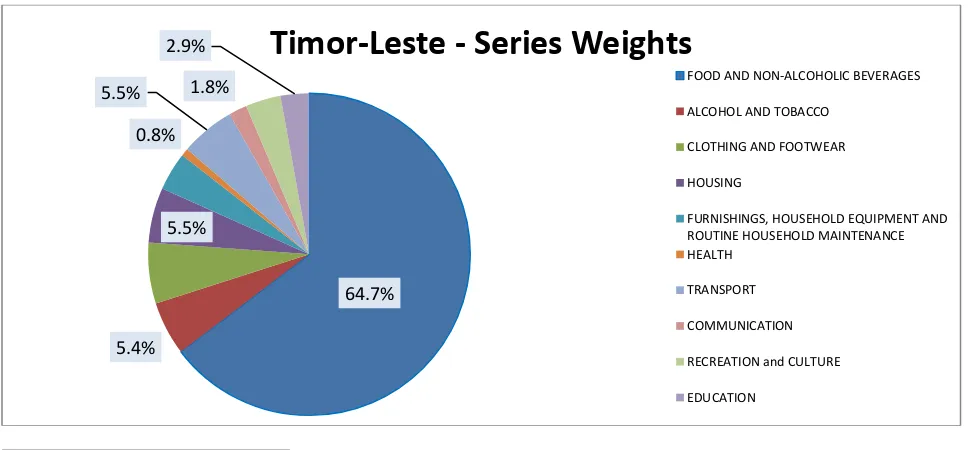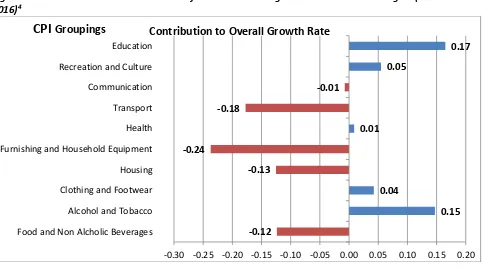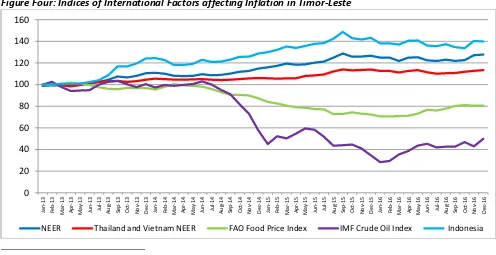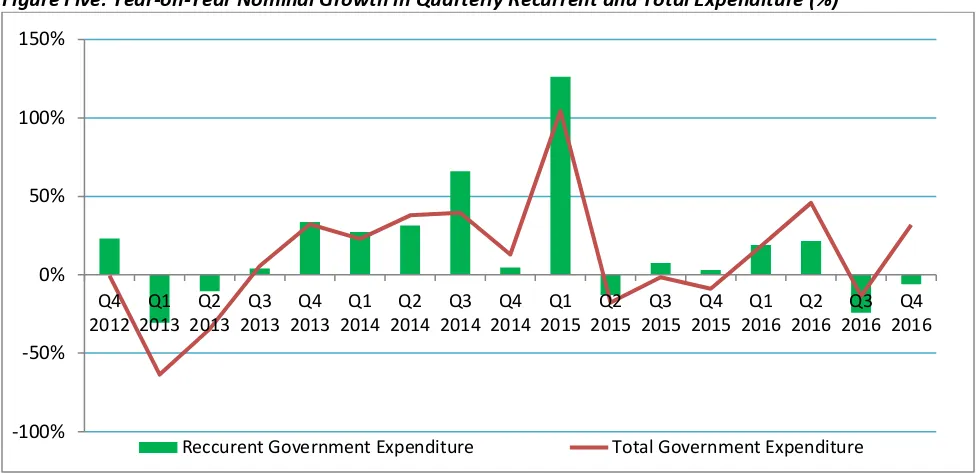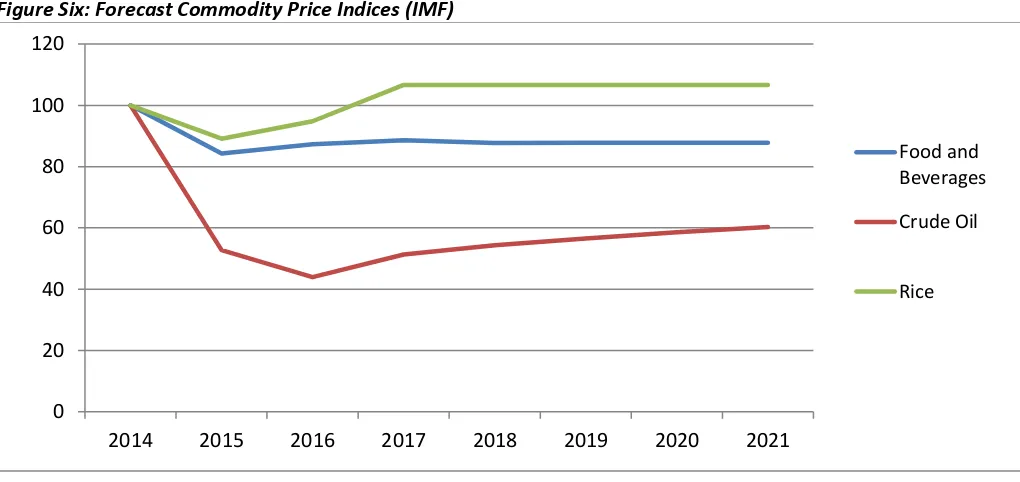1
QUA RT E R LY I N F L AT I O N
R E V I E W
SEPTEMBER - DECEMBER 2016
n.20EXECUTIVE SUM MARY
In December 2016, year-on-year (YoY) inflation in Timor-Leste was 0.0%, this rate is below the 4%-6% target
ra ge set out i the Go er e t’s Strategi De elop e t Pla but is the first month in over a year that Timor-Leste has ’t experienced falling prices (YoY). Quarter-on-quarter (QoQ) inflation in December 2016 was relatively strong at 0.7%; much higher than the rate seen in December 2015 (-0.7%) and the rate witnessed in September 2016 (0.0%).
Timor-Leste appears to be starting a slow exit from a deflationary environment as the international prices of oil and food begin to recover; the Food a d Agri ultural Orga izatio ’s FAO food pri e i de increased by 10.0% over the last twelve months. Due to the significant weight of food and non-alcoholic beverages in the CPI basket and the high proportion of food imported into Timor-Leste every year, international food prices remain one of the key drivers of the overall CPI rate and the MOF will continue to monitor price levels.
TREN DS I N I N FL ATION
In December 2016 YoY inflation in Timor-Leste was 0.0%; this means that a basket of goods and services that cost $100.00 in December 2015 will now cost $100.00 in December 2016 – on averages, prices are the same as one year ago. YoY inflation is higher than the rate seen in December last year (-0.6%). QoQ inflation in December 2016 was 0.7%; this is higher than the rate of -0.7% seen in December 2015 and the rate witnessed in September 2016 (0.0%), illustrating an upward trajectory.
Over the last few years, inflation in Timor-Leste has fluctuated widely (see Figure One). After a lengthy period of double-digit inflation between March 2011 and September 2013, inflation decreased dramatically and fell
elo the Go er e t’s 4%-6% target range in January 2014. By November 2015, Timor-Leste experienced deflation due to falling international oil and food prices. This episode of deflation appears to be drawing to an end with zero inflation in December 2016.
2
As seen in Figure Two, Food and non-alcoholic beverages account for approximately 65% of Timor-Leste’s CPI basket1, as nearly two thirds of Timorese household expenditure is spent on this group. Thus price movements
in this group will have a significant impact on the overall rate of inflation and the purchasing power of the Timorese citizens. YoY food and non-alcoholic beverage inflation in December 2016 was 0.0%, significantly higher than the rate of -1.9% witnessed in September 2016 and equal to the overall rate of the CIP.
Figure One: Year-on-Year Inflation in Timor-Leste
YoY core inflation2, which excludes the prices of particularly volatile items, namely food and non-alcoholic
beverages, turned negative at -0.2% in December 2016, down significantly from 1.6% in December 2015, illustrating that there are other goods pulling down the overall CPI rate.
Figure Two: Series weights in CPI Basket, December 2016
1 Timor-Leste’s CPI asket is ade up of the te e pe diture groupi gs see i Figure T o. 2 Calculated by the National Directorate of Economic Policy
-5%
Food and Non Alcholic Beverages Core inflation Timor-Leste Dili Districts
3
Over the past 12 months there have been significant price changes in the following expenditure classes3:
Housing (-2.0%)
Furnishing, household equipment and routine household maintenance (-5.8%) Transport (-3.2%)
Education (6.0%)
The largest upwards contributions (see Figure Three) to the overall year-on-year inflation rate in December 2016 came from:
Education (0.17 pp (percentage points)) Alcohol and Tobacco (0.15 pp)
The significant annual increase in education prices is a consequence of an increased cost of school admission fees in Dili in order to improve the quality and facilities of teaching in local schools.
The largest deflationary contributions (see Figure Three) to the overall year-on-year inflation rate in December 2016 came from:
Furnishing and Household Equipment (-0.24pp) Transport (-0.18 pp)
Housing (0.13 pp)
The large decrease in the price of Furnishings and Household Equipment is largely driven by a fall in the price of goods and services for routine household maintenance (-5.8%), namely toothpaste and shampoo products.
Figure Three: Contribution to Overall YoY Inflation Rates taking into account the CPI weights (December 2016)4
3 Expenditure classes are the sub-categories within an expenditure group in a CPI index 4 See concepts and terminology section for further explanation
-0.12
4
CAU SES O F I N FL ATION
5International Factors
An appreciation (depreciation) of the US dollar against the currencies of Timor-Leste’s ajor trading partners will put downward (upward) pressure on the price of imports in Timor-Leste. However, the effects of exchange rate and international commodity price movements on prices in Timor-Leste are likely to be felt some time after they occur6, as it takes time for the change in the price of imported goods to feed through to a change in the
price of consumer goods. For this reason exchange rate movement over the September 2015 to September 2016 period is analysed.
Between September 2015 and September 2016 Timor-Leste’s nominal effective exchange rate (NEER) Depreciated by -5.6%; this appears to have been driven by the 9.5%% depreciation of the US dollar against the Indonesian Rupiah. Over this period the US dollar also depreciated by -2.8% against a weighted Thai baht and Vietnamese dong basket. This depreciation placed upward pressure on rice prices (as these countries export large quantities of rice to Timor-Leste) and therefore inflation, as rice has a large weight in the CPI index. International oil prices experienced a small fall over the September 2015 to September 2016 period; the IMF’s crude petroleum price index fell7 by -2.8% on the year, however, continues to follow an upward trajectory. In
contrast, international food prices increased substantially over the period with the Food and Agricultural Organizatio ’s FAO food pri e i de increasing by 10.0%, countering the impact of the fall in the Vietnam and Thailand NEER.
Figure Four: Indices of International Factors affecting Inflation in Timor-Leste
5 Within this section inflation refers to YoY inflation 6 This analysis lags the impact by one quarter
7 The crude oil (petroleum) price index is a simple average of three spot prices; Dated Brent, West Texas Intermediate, and the Dubai Fateh.
5
Domestic Factors
Increases in Government expenditure, particularly recurrent expenditures such as transfers and salaries & wages, can have an inflationary impact on the economy. This is currently not the case in Timor-Leste; however, this is likely the result of a combination of other factors:
The favourable international conditions, as discussed above, may outweigh the domestic inflationary pressure coming from Government expenditure.
Increases in government expenditure often result in an increase in imports which can mediate the inflationary impact.
Downward inflationary pressure may be coming from other domestic factors on both the supply and demand side such as improvements in the supply side of the economy8 and decreased non-Government
aggregate demand.
Figure Five: Year-on-Year Nominal Growth in Quarterly Recurrent and Total Expenditure (%)9
The growth in the money supply of an economy is also likely to have some influence on inflation. Taking the average change in money supply across the year10, a 17.5% increase was witnessed. This may have impacted
upon inflation.
CON SEQ UE NCES OF IN FL ATIO N
Inflation will cause households’ purchasing power to fall, if increases in household income are lower than the increases in inflation. This situation is more likely to occur in a high inflation environment. Inflation which reduces consumers’ purchasing power can reduce living standards and may increase poverty. Thus the recent
8 The amount of money that can be spent in an economy before inflation begins to increase
9 This measures the year-on-year growth in quarterly nominal expenditure, i.e. the growth rate in Q3 2016 measure the change between nominal expenditure in Q3 2015 and Q3 2016.
10 Taking average money supply for the last 12 months and compare to average money supply in the previous 12 months.
-100%
6
negative inflation seen in Timor-Leste and the now zero inflation level is o siste t ith the Go er e t’s poverty reduction strategy.
IN FL ATIO N OUT L OOK
YoY inflation is likely to remain below the SDP target range (4%-6%) in the near term. The following factors are likely to have an impact on future rates of inflation in Timor-Leste:
International commodity prices
:
between September 2016 and December 2016, international food prices increased by 0.6% and the price of crude oil increased by 16.8%. As changes in commodity prices have a lagged effect on inflation in Timor-Leste, it is likely that these price changes will impact inflation in Q1 2017. Given the weight of food and oil i TL’s CPI asket, it is likel that the increasing prices of these goods will have a strong effect on the average price level. In the medium to long-term, while still low, the IMF have revised their commodity price forecast11 upwards; again, this is expected to place upward pressure on inflation.International exchange rates: between September 2016 and December 2016 Timor-Leste’s NEER appreciated by 4.8%. This puts some downward pressure on inflation by reducing the cost of imported goods and services. Government expenditure: the increase in Government expenditure over the last four quarters will result in increased inflationary pressure, the extent to which this will result in higher inflation depends on the impact of other factors and the econom ’s absorptive capacity.
Figure Six: Forecast Commodity Price Indices (IMF)
11 Primary Commodity Prices, IMF (http://www.imf.org/external/np/res/commod/index.aspx) 0
20 40 60 80 100 120
2014 2015 2016 2017 2018 2019 2020 2021
Food and Beverages
Crude Oil
7
ANN EX 1 : CO NCE PTS AN D TERMI N O L OGY
Consumer price inflation the rate at which the prices of goods and services bought by households increase or decrease.
The Consumer Price Index (CPI)12isused to measure consumer price inflation. To understand CPI think of a
large basket containing the goods and services bought by households, the CPI estimates the change to the total cost of the basket on a monthly basis.
Year-on-year (YoY) inflation is the most commonly used measure and is calculated by comparing the price index from a given period with the same month in the previous year. For example, the year-on-year inflation in December 2016 measures the percentage change in prices between December 2015 and December 2016.
Quarter-on-quarter inflation (QoQ) is calculated by comparing the price index from the last month of a given quarter (March, June, September or December) with the last month of the previous quarter13. Thus
quarter-on-quarter inflation in December 2016 measures the percentage change in prices between September 2016 and December 2016.
Month-on-month inflation (MoM) is calculated by comparing the price index from the latest month to the previous month. Thus the month-on-month inflation in December 2016 measures the percentage change in prices between November 2016 and December 2016.
Contribution to inflation rate measures the contribution to the overall rate of inflation of a grouping of goods and services, a groups contribution to the overall rate of inflation is determined by its growth rate and weight within the series14.
Nominal effective exchange rate (NEER) is the eighted a erage alue of a ou tr ’s urre relati e to the
currencies of its major trading partners.
Core inflation is a measure of inflation which excludes certain items that face volatile price movements. Core inflation eliminates products15 that can have temporary price shocks because these shocks can cause a
divergence from the overall trend in inflation giving a false measure of inflation.
Purchasing Power measures the quantity of goods and services which can be purchased with a unit of currency. All else being equal inflation decreases the amount of goods and services a consumer is able to purchase with their monthly salary.
Timor-Leste’s Co su er Pri e I de is pu lished o thl Ge eral Dire torate of Statisti s MoF16. This index
is divided into 10 specific groups representing specific sets of commodities such as food and non-alcoholic beverages, housing and transport. In addition, separate consumer price indices are compiled for both Dili and the districts.
12The CPI is a eighted i de ea i g that the i flue e o the CPI i de of a gi e ite is depe de t o the ite ’s share in total household consumption.
13 In this publication
14 The contributions of each grouping will sum to give the overall rate of inflation
15 The core inflation index in Timor-Leste excludes all food and non-alcoholic beverage items
8
ANN EX 2 : NOTE S
This bulletin is produced by the National Directorate for Economic Policy, Ministry of Finance, on a quarterly basis, in both English and Tetum. Please refer any queries to the below contacts:
1. Epifanio Martins, Director of NDEP Email: [email protected]
2. Nelio Francisco B.S. Mesquita, Analyst Email: [email protected] 3. Dayna Connolly, Macroeconomist
